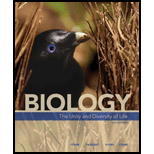
Concept explainers
One Tough Bug The genus Ferroplasma consists of a few species of acid-loving archaea. One species, Ferroplasma acidarmanus, was discovered in one of the most contaminated sites in the United States: Iron Mountain Mine in California. F. acidarmamus is the main constituent of .slime streamers (a type of biofilm) growing in water draining from this abandoned copper mine (right). The water is hot (about 40°C, or 104°F), heavily laden with arsenic and other toxic metals, and has a pH of zero.
F. acidarmanus cells have an ancient energy-harvesting pathway that uses electrons pulled from iron-sulfur compounds in minerals such as pyrite. Removing electrons from these compounds dissolves the minerals, so groundwater in the mine ends up with extremely high concentrations of solutes, including metal ions such as copper, zinc, cadmium, and arsenic. The pathway also produces .sulfuric acid, which lowers the pH of the water around the cell to zero.
F. acidarmanus cells keep their internal pH at a cozy 5.0 despite Living in an environment similar to hot battery acid. However, most of the cell’s enzymes function best al much lower pH (FIGURE 5.13). Thus, researchers think F. acidarmanus may have an unknown type of internal compartment that keeps their enzymes in a highly acidic environmental.


FIGURE 5.13 pH anomaly of Ferroplasma acidarmanus.
Left graphs showing pH activity profile of four enzymes isolated from Ferraplasma acidarmanus Researchers had expected all of these enzymes to function best at the calls’ cytoplasmic pH (5.0).
What do the dashed lines in the graphs signify?
To determine: What do the dashed lines in the graphs signify.
Concept introduction: Enzymes are the protein molecules that enhance the rate of the reactions without being changed by them. It acts as a biocatalyst. Each enzyme works the best within a certain range of environmental conditions that include temperature, pH, and salt concentration.
Explanation of Solution
The isolated bacteria Ferroplasma acidarmanus grow well at acidic environment (pH zero) of copper mine where the water temperature is about 40 ºC and heavily laden with arsenic and other toxic metals.
The F. acidarmanus has an ancient energy harvesting pathway. It uses the electrons from iron-sulfur compounds in the mineral such as pyrite. Removing electrons from these compounds dissolve the minerals that lead to the high concentration of metal ions such as copper, zinc, cadmium, and arsenic in groundwater. This also produces sulfuric acid which lowers the pH of the water around the cells to zero.
Despite the surrounding environment the internal pH of the bacteria is 5.0. However, most of the enzymes in bacteria functions best at much lower pH. This causes a thinking of presence of the unknown type of internal environment in the bacteria that keeps their enzymes in a highly acidic environment.
Refer to Fig. 5.13 “pH anomaly of Ferroplasma acidarmanus”, there are four different enzymes carboxylesterase, α-glucosidase, GlyFa1, and GlyFa2 which works best around pH 1.5, 3, 1.8, and 3.8 respectively. The dashed line shows the optimum activity for each enzyme.
The dashed line indicates the optimum enzyme activity for each enzyme.
Want to see more full solutions like this?
Chapter 5 Solutions
Biology: The Unity and Diversity of Life (MindTap Course List)
Additional Science Textbook Solutions
Genetics: From Genes to Genomes
Laboratory Manual For Human Anatomy & Physiology
Microbiology Fundamentals: A Clinical Approach
Human Physiology: An Integrated Approach (8th Edition)
- What did the Cre-lox system used in the Kikuchi et al. 2010 heart regeneration experiment allow researchers to investigate? What was the purpose of the cmlc2 promoter? What is CreER and why was it used in this experiment? If constitutively active Cre was driven by the cmlc2 promoter, rather than an inducible CreER system, what color would you expect new cardiomyocytes in the regenerated area to be no matter what? Why?arrow_forwardWhat kind of organ size regulation is occurring when you graft multiple organs into a mouse and the graft weight stays the same?arrow_forwardWhat is the concept "calories consumed must equal calories burned" in regrads to nutrition?arrow_forward
- You intend to insert patched dominant negative DNA into the left half of the neural tube of a chick. 1) Which side of the neural tube would you put the positive electrode to ensure that the DNA ends up on the left side? 2) What would be the internal (within the embryo) control for this experiment? 3) How can you be sure that the electroporation method itself is not impacting the embryo? 4) What would you do to ensure that the electroporation is working? How can you tell?arrow_forwardDescribe a method to document the diffusion path and gradient of Sonic Hedgehog through the chicken embryo. If modifying the protein, what is one thing you have to consider in regards to maintaining the protein’s function?arrow_forwardThe following table is from Kumar et. al. Highly Selective Dopamine D3 Receptor (DR) Antagonists and Partial Agonists Based on Eticlopride and the D3R Crystal Structure: New Leads for Opioid Dependence Treatment. J. Med Chem 2016.arrow_forward
- The following figure is from Caterina et al. The capsaicin receptor: a heat activated ion channel in the pain pathway. Nature, 1997. Black boxes indicate capsaicin, white circles indicate resinferatoxin. You are a chef in a fancy new science-themed restaurant. You have a recipe that calls for 1 teaspoon of resinferatoxin, but you feel uncomfortable serving foods with "toxins" in them. How much capsaicin could you substitute instead?arrow_forwardWhat protein is necessary for packaging acetylcholine into synaptic vesicles?arrow_forward1. Match each vocabulary term to its best descriptor A. affinity B. efficacy C. inert D. mimic E. how drugs move through body F. how drugs bind Kd Bmax Agonist Antagonist Pharmacokinetics Pharmacodynamicsarrow_forward
 Biology Today and Tomorrow without Physiology (Mi...BiologyISBN:9781305117396Author:Cecie Starr, Christine Evers, Lisa StarrPublisher:Cengage Learning
Biology Today and Tomorrow without Physiology (Mi...BiologyISBN:9781305117396Author:Cecie Starr, Christine Evers, Lisa StarrPublisher:Cengage Learning Biology: The Unity and Diversity of Life (MindTap...BiologyISBN:9781337408332Author:Cecie Starr, Ralph Taggart, Christine Evers, Lisa StarrPublisher:Cengage Learning
Biology: The Unity and Diversity of Life (MindTap...BiologyISBN:9781337408332Author:Cecie Starr, Ralph Taggart, Christine Evers, Lisa StarrPublisher:Cengage Learning BiochemistryBiochemistryISBN:9781305577206Author:Reginald H. Garrett, Charles M. GrishamPublisher:Cengage Learning
BiochemistryBiochemistryISBN:9781305577206Author:Reginald H. Garrett, Charles M. GrishamPublisher:Cengage Learning Biology 2eBiologyISBN:9781947172517Author:Matthew Douglas, Jung Choi, Mary Ann ClarkPublisher:OpenStax
Biology 2eBiologyISBN:9781947172517Author:Matthew Douglas, Jung Choi, Mary Ann ClarkPublisher:OpenStax





